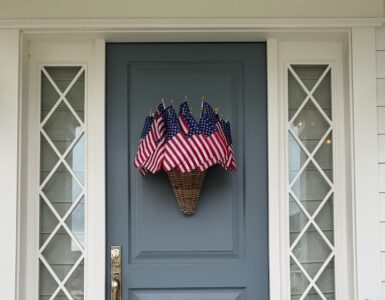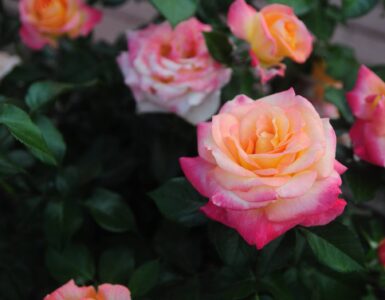Don’t worry if you don’t have a green thumb or don’t have a lot of space for an outdoor garden. The new trend is to plant a vertical garden which is easy to maintain, can provide lots of fresh herbs for cooking, and can even give you a little extra privacy in the backyard.
Cynthia Bee, from the Jordan Valley Conservation Garden shares her plans for a vertical garden.
I am SO excited to share this post today! I can’t count how many gardening books I’ve read or home improvement show episodes I’ve watched that glamorize that very idea. There isn’t a gardener, cook or everyday homeowner who doesn’t dream of having a full contingent of fresh herbs growing right near the back door for use in the kitchen. There are, however, PLENTY of those self-same individuals who lack the space for such an idea. Today we’ll show how to create an awesome, adjustable kitchen herb garden capable of containing DOZENS of herbs that can be enjoyed by homeowners and apartment dwellers alike. As an added benefit, this “Vertical Kitchen Herb Garden” can also help create privacy for your deck or back patio!
As much as I’d love to claim full credit for this fabulous idea, the credit belongs to Ryan Saddler of OMG Landscaping. Ryan designed and built this free-standing deluxe metal version out of welded metal and 2″ wire mesh. The frame itself is also welded metal. If you can spend several hundred dollars on a unit, then purchasing one of these ready-made by OMG Landscaping is the quickest and most permanent solution.
However, with some minor modifications, a similar unit can be built from Redwood and Cedar then filled in with 4″ square metal “cattle panels” which can be purchased at farm supply stores. Expect to spend about $100 to make this project yourself from wood.
MATERIALS
Screen:
2- 2 x 6 x 8 foot Redwood boards
1- 2 x 6 x 10 foot Redwood board
1- 5 x 8 welded wire cattle panel* ($55 for a 5′ x 16′ long piece at Steve Regan Company, you’ll need half of one for a single unit)
2- 2 x 2 x 8 foot redwood or cedar boards
1- 2 x 2 x 10 foot redwood or cedar board (usually used for pickets on railings)
2″ outdoor screws
* Note: you must use WELDED wire mesh that is made of at least 1/4″ metal tubing. The wire mesh purchased at home improvement stores will NOT be strong enough to hold the weight of the boxes once they are fully-loaded with soil and water. You can use either the 2″ welded wire mesh, as shown in the example, or 4″ welded wire cattle panels. The 2″ wire mesh allows for more variety in placement of the boxes but is more expensive than the 4″ wire mesh.
Boxes:
12- 1 x 6 x 8 Cedar fence slats- make sure the wood has not been chemically treated, food will be going in here!
1 5/8″ outdoor screws
12- metal L-brackets
Optional: weed barrier fabric to line the boxes.
Note: if you want the panel to be free standing, it would be best to build a 1 foot wide by 5 foot long by 18″ tall planter box at the bottom to act as a “foot”. Otherwise, plan to attach the screen with 2″ minimum depth spacers to a wall or attach it to a deck or patio railing. The advantage to the planter box base is that you’ll be able to grow some larger plants or even vegetables in the unit.
Tools:
Table or Miter saw to cut lumber to length
Counter-sinking drill bit and drill
FRAME ASSEMBLY:
The size of this unit is about 8 feet tall by 5 feet wide. The screen itself is only 6 inches deep but, in order to be freestanding, there are “feet” on the bottom which are 24″ long. If you’re installing this on a wall, fence or attaching between railing posts on a deck, the “feet” won’t be necessary.
The dimensions of the entire unit are based off the dimensions of your wire mesh. You’ll build a 2 x 6 “frame” around the wire mesh, the 2″ side will be the face and the 6″ side will provide the depth. Once you have the frame made, screw the 2 x 2 lumber to the inside, flush with the back of the frame. Lay the wire mesh on the 2 x 2 inside frame then create the same inner frame on the front, sandwiching the mesh between the 2 x 2 layers, which completes the screen portion.
One of the advantages of the wire mesh over a solid wall is that air can still pass through the mesh which means there is less wind resistance and thus it’s more stable than a solid wall would be. Even so, if you wish for the unit to be free standing, I cannot more highly recommend that you build a larger planter box at the base of the unit. This will give you one large planter that can contain vegetables, like a tomato plant and cucumbers or squash to climb the mesh. The more important reason is that the large planter creates a weight at the bottom of the unit that will act as the “foot” needed for the freestanding feature to work.
BOX ASSEMBLY:
We created three box sizes:
4 1/2 foot long
2 3/4 foot long box
2 foot long box.
You can create whatever box sizes make you happy! The key for box assembly is to make sure the front piece of the box is one smooth piece which means it should overlap the bottom and sides. To assemble, simple cut a piece of the 1 x 6 cedar fence picket 1 1/2 inches SHORTER than you want the finished box to be. Cut the front and back of the box to the desired FINISHED size then used the counter-sinking drill bit to pre-drill the holes and attach the front and back to the bottom leaving 3/4″ overlap on the ends for the sides of the box. Cut pieces of 1 x 6 cedar to fit the side opening and assemble the rest of the box as you did the face.
To add the hooks, place the finished box in the approximate location you’ll use it in the frame and measure the right location for the brackets, spacing them approximately 6 inches from the ends of the boxes. Attach the brackets with 2 screws or for a more professional finish, use 1/4″ wide by 1 inch long carriage bolt using a washer and nut on the inside of the box.
Long Boxes: Make as directed above but place an extra piece of cedar on the INSIDE of the box in the middle and secure it with screws, this will keep the box from bowing under the weight of the soil and water. I would also recommend a 3rd attachment bracket for longer boxes.
Optional: Line the boxes with weed barrier fabric to prevent soil from washing through cracks in the boxes and help hold in water just a bit longer. Staple the fabric to the cedar with a hand-held construction stapler if desired.
PLANTING:
We are using this planter for herbs because MOST herbs are naturally waterwise. These boxes are relatively small and so to hold in moisture, I’m using my tried-and-true container gardening mixture which consists of 1/2 potting soil and 1/2 Coconut “Coir” (sometimes called Coconut Fiber). I purchase it ready-to-use in bags from Steve Regan Products in Murray, Utah but it can also be found in a compressed brick form from Miller Companies at the better-quality nurseries in town.
The coconut coir holds 10x it’s weight in water. As the potting soil around it dries out, it wicks the moisture out of the Coconut Coir thus ensuring a more evenly moist growing medium which plants really appreciate! You’ll appreciate being able to water a little less often too!
I mix my soil blend in a wheelbarrow then fill the boxes!
TIP: NEVER plant into dry soil whether your planting a container or a shrub in your landscape, always wet down the soil media that will come in contact with the root ball of your plant. Failure to do this may dry out the root ball and kill the plant.
As for planting, we put our Bronze Fennel and Dill in the highest planter since they’ll grow the tallest. Our most drought-tolerant herbs fill the upper boxes. We tried to keep the perennial herbs together in the same boxes and the annual herbs together in their own box. Our LEAST drought tolerant herbs such as Cilantro and Basil fill the lowest box- this will allow them a bit more shade and the bottom box will absorb any extra moisture that drains from the boxes above them.
HERB IDEAS:
This is an especially great solution for herbs such as mint that spread obnoxiously in the landscape- our vertical boxes contain them! I still hope to add a regular mint and chocolate mint to the boxes- might have to build 1 more box to do it! I selected herbs for their use primarily but also threw in a few extras whose leaves are lovely colors. Mix creeping herbs that can fluff over the edges of the boxes with upright herbs that can fill in the voids between the boxes! The herbs we used are listed from top to bottom. You can modify the list as desired.
Top Box: Bronze Fennel, Dill
Box 2: Lemon Balm, Creeping Thyme, Lemon Verbena
Box 3: Chives, Oregano, Garlic Chives
Box 4: Grapefruit Mint, Chamomile, Pineapple Mint, Purple Sage, Apple Mint
Box 5: Holy Basil, Italian Parsley, Lemon Thyme, Rosemary, Golden Oregano
Bottom Box: Piccolo Basil, Cilantro, Purple Ruffles Basil, Curled Parsley, Genovese Basil















Add comment